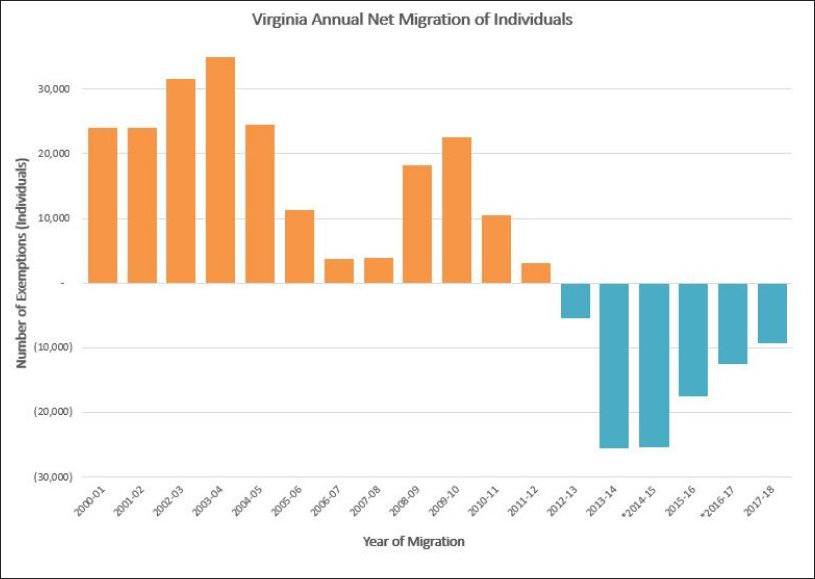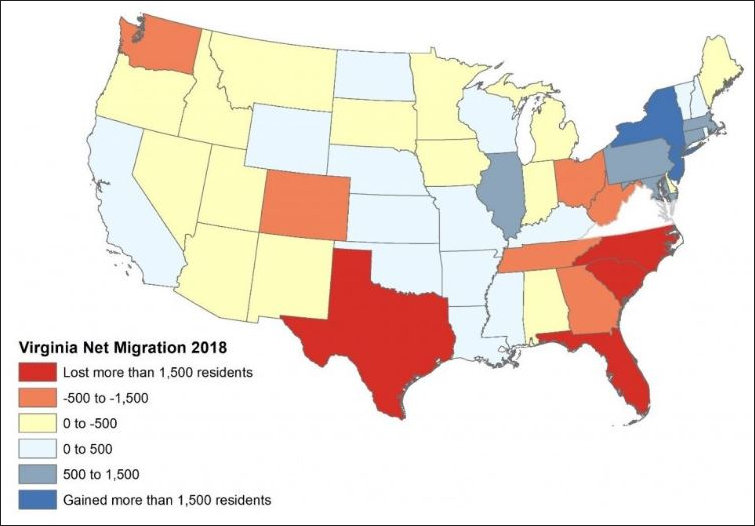
by James A. Bacon
The net out-migration of Virginian taxpayers continued in 2018, extending a six-year trend and contributing to the slowest rate of population growth in Virginia since the 1920s when African-Americans were fleeing the state’s oppressive Jim Crow laws. If there’s a silver lining to the data published by the University of Virginia Demographics Research Group in its StatChat blog, it’s that the rate of emigration seems to be slowing.
Annual population growth in the Old Dominion peaked at 2.4% in the 1940s, driven by the Baby Boom, and has slowed since. By the 2000s, population growth had fallen to 1.3% annually. In the decade of the 2010s, it plunged to 0.7% — a slower rate of growth than in the Great Depression (1.1%). One has to go back to the 1920s (0.5%) to find a lower rate of growth.
Hamilton Lombard offers this analysis:
The recent shift in Virginia to out-migration has been driven, just as during the 1920s, by changes within Virginia’s economy, principally Northern Virginia’s economy. Decades of above average economic growth in the Washington DC area, in large part due to the expansion of the federal government, attracted hundreds of thousands of people to the region, fueling the majority of Virginia’s population growth by the 1980s. … But for much of the 2010s, economic growth in the DC area has lagged the rest of the U.S., in part due to the Federal Budget Sequestration.
Despite its slowdown, Northern Virginia is still growing faster than the Rest of Virginia (RoVa), thanks mainly to an influx of foreign immigrants, a younger population and a surplus of births over deaths. By contrast, in 2018, 64 of Virginia’s 95 counties had more deaths than births.
The aging of the population and the slowing birth rate is affecting communities across the United States. But the chronic loss of taxpaying households, as measured by the Internal Revenue Service, suggests a decline in Virginia’s economic dynamism.

This map from StatChat shows where in-migrants are coming from (politically “blue” states to the north, mostly the Mid-Atlantic and New England) and where they’re going (“red” states, mostly, including Texas and states to the south).
The morsel of consolation is that the rate of out-migration seems to be slowing. The net loss of migrants peaked at 20,000+ in 2013-14 and 2014-15, but declined to fewer than 5,000 in 2018. One can hope that the state reached break-even in 2019. The influx of Amazon jobs in Arlington could push Virginia into positive territory in the next few years.
In other demographic news, Lombard reported a couple of milestones for 2019:
- The City of Chesapeake surpassed Norfolk as the second most populous locality in Hampton Roads, exceeded only by Virginia Beach.
- Montgomery County, home to Virginia Tech, passed the 100,000 mark, making it the largest locality west of the Blue Ridge Mountains.

Leave a Reply
You must be logged in to post a comment.